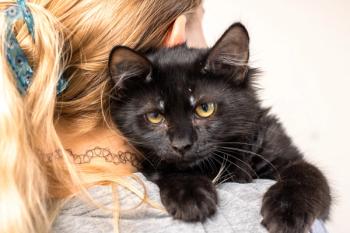
- Vetted March 2019
- Volume 114
- Issue 2
Bring down the stress in boarding
You cant guarantee that every patient or pet staying in your veterinary hospitals boarding wont get scared, but you can make some small tweaks to make their stay less stressful and more comforting.
For a better boarding experience, this cat needs to be separated from dogs, out of sight of other animals and given a place to hide inside its enclosure. It's easy to assume that a boarding environment in your veterinary hospital can't ever really be comfortable for the residents, because it isn't home. This actually need not be the case.
Creating a Fear Free boarding environment does not mean a complete facility makeover. Far from it! Attention to detail, some imagination and an understanding of Fear Free principles-coupled with the willingness to look at the boarding experience from your patients' perspective-can transform simple overnight care to true tender loving care.
Use your space: Separate cats and dogs
This may seem self-evident, but I've been in facilities that still house cats and dogs in the same wards. Even in a small physical plant, your patients' emotional well-being is best served by keeping dog and cat spaces separate.
Adjust sight lines: Provide visual barriers
Fear Free boarding means creating visual barriers between occupants. One example is making all the cages in a ward face a single direction to eliminate any aggressive posturing or the stress of feeling pursued or dominated by patients across the way. Some pets may appreciate a privacy curtain at the front of their spaces.
Adjust sight lines: Cats like to hide and go vertical
If possible, install cat-specific condos. These provide great flexibility in housing, and most have built-in shelves for cats to climb onto. There are also made-for-cats cubbies that can be placed in an existing cage to provide privacy and offer a raised surface for perching.
Change your protocols: Pheromones, pheromones, pheromones
You can't overdo pheromones:
Change your protocols: No harsh chemicals, please
Quaternary ammonia and bleach products are effective at killing bugs, but equally effective at rendering cats and dogs “nose blind.” Cats and dogs rely heavily on their sense of smell, so it's incredibly disorienting for them to lose that sense. It's time to use the same accelerated hydrogen peroxide products that are used in most human hospitals. (Virox makes
Touch up your interior design: What's on your walls?
Paint is an inexpensive way to make big visual changes. For years, bold colors were “in.” But when we look at the boarding experience from the pets' perspective, we need to consider their emotional well-being. Pastels and pale colors
Touch up your interior design: Lights, lights, lights
Pets don't enjoy traditional fluorescent lights. They can hear the constant hum of the fixtures, and the conventional fluorescent spectrum is harsh.
Change your protocols: Make some music
Audiology research has revealed that certain pitches and rhythms induce a physiologic relaxation response in cats and dogs (different for each-no surprise). There are music players available from
Change your protocols: Don't wait-medicate
Finally, be aware of the various nutraceuticals that have been shown to decrease anxiety. This may be an important component of creating a Fear Free boarding experience. Be sure to gain pet owner consent before providing these options.
As you can see, with a bit of forethought, a relatively small monetary investment and a little imagination, you can transform a so-so or stressful boarding experience into a fabulous “Fear Free resort” experience.
Dr. Robin Downing, who holds a master's degree in clinical bioethics, is a diplomate of the Academy of Integrative Pain Management, a diplomate of the American College of Veterinary Sports Medicine and Rehabilitation, a certified veterinary pain practitioner, a certified canine rehabilitation practitioner, and hospital director at the Downing Center for Animal Pain Management in Windsor, Colorado.
Articles in this issue
almost 7 years ago
Storage wars: Animal hospital editionalmost 7 years ago
Should you have been a plumber? Comparing vet team pay to other jobsalmost 7 years ago
'Never have I ever ... ': Veterinary editionalmost 7 years ago
5 quick Q&As on cannabidiol use in veterinary practicealmost 7 years ago
Suspect GI bleeding? What to do when you don't see redalmost 9 years ago
Up close and personal with 4 common ticksNewsletter
From exam room tips to practice management insights, get trusted veterinary news delivered straight to your inbox—subscribe to dvm360.






